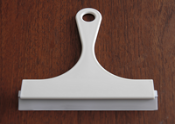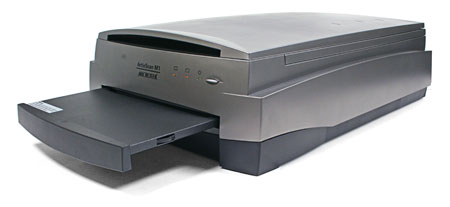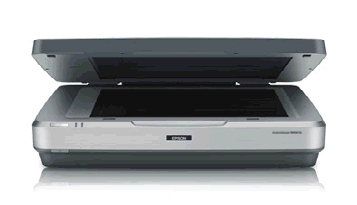- Originally popularized by Agfa these units were popularized by Microtek's own
branded units. On the expiration of the Agfa contract Microtek scanners like the M1/F1
were made in greater resolution versions. This model includes auto-focus.
- ScanScience kits for this scanners consist of overlays and accessories which the
user utilizes to wet mount on the glass tray of the scanner, relying on the glass drawer
insert provided with the scanner as the surface onto which the fluid mount is built.
These kits do not include an adapter nor a glass plate, as in fact the scanner glass
drawer is used to mount fluid mount. With the film fluid mounted onto the glass, the
ULTRANS overlay is fluid mounted to the film backing. The whole assembly is then
taped to the glass.
- Microtek has recently re-started marketing operation in the US which is welcome
news for Photographers.
- Favorite Models of this series are the ArtixScan 1800f, Microtek's first USB 2.0
scanner, ArtixScan F1, (M1) 4800dpi/ 48-bit, 4.2 Dmax, Dual media design for
scanning photos and film, E.D.I.T. glassless film scanning technology, Smart Auto
Focusing technology, templates for 35mm slides, strips, medium format (up to 6 x 17
cm panoramic) & 4" x 5" film, Reflective: 8.5" x 14", Transparent: 8.0" x 10", Hi-Speed
USB 2.0.
- These scanners can scan film without the added refraction of the flatbed glass, as
is the case with flatbed scanners. These scanners have dual light sources. This
increases the price of the scanner but potentially, elevates the scanner in the realm of
full FILM scanners.
- Ordinary flatbeds combine both functions for both opaque and transparency (film),
the Microtek Dual Film / Flatbed scanners have separate hardware for reflective and
transparency materials.
- For a full review here is the web link: http://www.pcmag.com/article2/0,
2817,2294136,00.asp?tab=FullReview.
- Dust: In common with all film scanners, special care must be taken to prevent dust in
the scanner chamber.
|
|
.
- The Creo resolution goes up to 8000 dpi. in some models
and the price goes to $25K.
- Although technically possible with these scanner to fluid
scan on the flatbed because of the autofocus feature, this
is not recommended. Having fluid all over the glass bed
invites problems with the seals, and since there is no
refraction from the scanning glass in the ScanScience
system, it is better to use the ScanScience adapters which
alloy you to prepare the fluid mount away from the scanner
and place the wet mount assembly on the scanner when it
is externally dry.
- The Epson can focus in the range of 5 mm, 2.5 mm above
and below the bed. The ScanScience adapters for
autofocus scanners place the focus 0.5 mm above the
glass bed.
- The ScanScience adapter covers the entire area of the
scanner to maximize dynamic range, and is cut to the size
of the film and the scanning plate.
- The film is positioned on the glass according to the
position of the sensors:
- If the sensors are on the lid the film is placed on the
scanning glass.
- If and it the sensors are on under the glass bed, the
film is positioned under the glass.
- With the Microtek M1 the sensors are under the
glass, and the film is positioned under the scanning
glass also.
The Scanscience kits available for these scanners can be
seen in the catalog and price list under the by clicking Tab4
-Other Flatbeds
|
|









